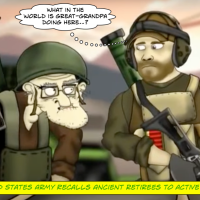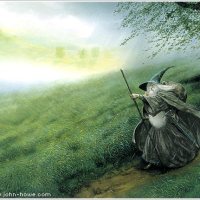 Part of the great fun of teaching is having students bring work to me. In just one class students have had me scurrying to Thomas Malory’s Le Morte d’Arthur, J.R.R. Tolkien‘s “The Last Ship,” Beowulf, Hayao Miyazaki’s Spirited Away, Bruce Elliot’s “Wolves Don’t Cry,” the Völsung Saga, and a little three-verse poem, “The Flea,” by John Donne. The Bruce Elliot story is entirely new to me and makes an intriguing Hallowe’en recommendation as it is creepy and disturbing and fitting for the eve of All Saints Day. However, I think the Hallowe’en allows us to look at “The Flea” in a new way.
Part of the great fun of teaching is having students bring work to me. In just one class students have had me scurrying to Thomas Malory’s Le Morte d’Arthur, J.R.R. Tolkien‘s “The Last Ship,” Beowulf, Hayao Miyazaki’s Spirited Away, Bruce Elliot’s “Wolves Don’t Cry,” the Völsung Saga, and a little three-verse poem, “The Flea,” by John Donne. The Bruce Elliot story is entirely new to me and makes an intriguing Hallowe’en recommendation as it is creepy and disturbing and fitting for the eve of All Saints Day. However, I think the Hallowe’en allows us to look at “The Flea” in a new way.
 Is this a love poem? Is it a satire? Is it the playful bedtime play of lovers? Is it a brazen porn-riddled wink at 17th-century authority? Should Freud have a say? Or Shakespeare’s censor? Is it the prophetic warning that whatever love may bring there is always an epidemic nearby? Is it a reflection upon the mystery of lovers’ union? the mingled blood of the marriage bed? the mutual submission that is self-death in the giving of one’s self to the other?
Is this a love poem? Is it a satire? Is it the playful bedtime play of lovers? Is it a brazen porn-riddled wink at 17th-century authority? Should Freud have a say? Or Shakespeare’s censor? Is it the prophetic warning that whatever love may bring there is always an epidemic nearby? Is it a reflection upon the mystery of lovers’ union? the mingled blood of the marriage bed? the mutual submission that is self-death in the giving of one’s self to the other?
Or does our attentiveness to darkness at Hallowe’en and the Gothic and horror traditions that attend it teach us another way to read this poem? Is there not something monstrous and murderous and vampyric about this little poem, set in triadic loops of death and blood?
Mark but this flea, and mark in this,
How little that which thou deniest me is;
It sucked me first, and now sucks thee,
And in this flea our two bloods mingled be;
Thou know’st that this cannot be said
A sin, nor shame, nor loss of maidenhead,
Yet this enjoys before it woo,
And pampered swells with one blood made of two,
And this, alas, is more than we would do.
Oh stay, three lives in one flea spare,
Where we almost, nay more than married are.
This flea is you and I, and this
 Our marriage bed, and marriage temple is;
Our marriage bed, and marriage temple is;
Though parents grudge, and you, w’are met,
And cloistered in these living walls of jet.
Though use make you apt to kill me,
Let not to that, self-murder added be,
And sacrilege, three sins in killing three.
Cruel and sudden, hast thou since
Purpled thy nail, in blood of innocence?
Wherein could this flea guilty be,
Except in that drop which it sucked from thee?
Yet thou triumph’st, and say’st that thou
Find’st not thy self, nor me the weaker now;
’Tis true; then learn how false, fears be:
Just so much honour, when thou yield’st to me,
Will waste, as this flea’s death took life from thee.






















“Is it the prophetic warning that whatever love may bring there is always an epidemic nearby?” For us, and, if their epidemiology had been a bit better, for them, too. But that absence of entertaining the possibility of infusing into the other what it has extracted from the one, makes me aware that one creepy dimension not invoked is that of succubus-incubus.
I heard a jolly lecture by Sir Brian Vickers putting the case for the semi-dramatic rather than ‘autobiographical’ character of poems like this and Andrew Marvell’s “To His Coy Mistress”, but, if we posited autobiography, here: Anne More, Vampire Killer? (And, when ‘parents grudged’ like crazy, John Donne, Prisoner of Love?)
This is a critical points we forget in the HIV era: we cannot view blood the same anymore. This is true in the whole modern era bit we feel differently now. Vampire stories are based on folktales but are a modern phenomenon.
The soul of a person being in the blood? The book & movie “The Childeren’s act” by Ian McEwan is about that …? https://www.imdb.com/title/tt6040662/
I’ve never heard of that movie, but it looks amazing. “Life is more precious than dignity.”
I don’t want to share why I think JWs don’t share blood, honestly.
I was rather thinking of this story, than the JW’s reasons for not sharing blood sharing:
How the Heart, in the old (medieval) system the source of all life where sin originates, changed into a pump.
According to Galenus, a Greek physician and philosopher in the Roman Empire (130 – 210 AD), a liquid is produced by the liver, receives oxygen in the lungs and then continues on to the heart where through heating life spirits are added. This liquid then spreads through the body and causes the various moods: when the life spirits are on fire, the blood will circulate faster and you will become excited / with less blood you will feel weak and ill. The life spirits are fed to the blood in the lungs and escape through the mouth in warm breath. For this system you need a hole between the left and right side of the heart..
Around 1300 they started to study anatomy and in Bologna found something that looked like a hole.
In 1550 Vesalius claimed that there was no hole, only bulgings, but he was declared to be insane, lost his job at the Spanish court, was even imprisoned and died in poverty. And as a reaction ‘the sacred heart of Jesus’ mysticism started.
Only by 1628 Harvey, after a lot of persuasion, published a dull, technical booklet, in which he described the blood circulation as a small one through the lungs for oxygen and a large circuit through the body via 2 separate hart rooms, without a hole. Then he writes: “you have to understand in the name of God that the heart is a pump of the blood circulation”.
So, e.g., is water only H2O, or Christ’s “spring of water that bubbles up into eternal life”
that ‘old way’ of thinking remaining prevalent in John Donne’s (and Shakespeare’s) time?
I think it probably leaked through, but thanks for filling me in on some of this history.
I wasn’t thinking of it as history, more as an example of the water-shedding change over centuries in thinking, in seeing and understanding reality (like in Lewis’s ‘the Discarded Image’), but reflecting upon it made me wonder if a lot of history is about the actions as result of people’s thinking?
That’s a good question, and I’ve been thinking for a few days about it. I honestly, though, don’t know–or don’t have the clarity to create an idea around it. I’ve been thinking a lot about what “history” is.
Ah, great that you saw it! I also walked around with it for days before posting, and also having no clear ideas, but do have an inkling about what it shouldn’t be … only the dry facts and dates.
Maybe it would be interesting to trace how their approaces have changed through the ages? Eg from medieval chroniclers like the Benedictine monk Bede (ca 730) and Eadmer (ca 1100) historian, theologian, and ecclesiastic with “Vita Anselmi” – history of Anselm’s life (some Wikipedia search results …).
Your next posts with photos from Oxford also seem quite historic? ;-))
Thanks – I don’t think I remember ever hearing about this (as novel or film), though I am generally conscious of Ian McEwan (taught by the late Inklings scholar, Stephen Medcalf, who had himself been tutored by Dyson) as somebody I have not caught up with, yet…
I have been thinking about that perception (e.g., Leviticus17) in the context of the prayer (of Humble Access’) in the Book of Common Prayer Order for the Administration of the Lord’s Supper or Holy Communion, which includes “Grant us, therefore, gracious Lord, so to eat the flesh of thy dear Son Jesus Christ, and to drink his blood, that our sinful bodies may be made clean by his body, and our soul washed through his most precious blood, and that we may ever more dwell in him, and he in us.”
I find that The Prayer Book Dictionary (1912) has an interesting entry about it (under “Humble Access”, p. 396):
https://archive.org/details/theprayerbookdic00unknuoft/page/396
It seems a nice accent at once on wholeness and distinction (body and soul, flesh and blood, God and Man) also in needs and benefits with respect to what Charles Williams attends to in terms of Coinherence – “that we” – each of us, personally – “may ever more dwell in Him, and He in us.”
I need to reread Dracula – I think there is something about transfusions of animal blood (I also remember something from somewhere – Dracula, too? – in the early days of transfusions about sheep being brought with army units to be available to provide blood as needed (!)…).
Yes, I’ll have to reread that too. Amazing book.
Pingback: What Counts as an Old Book? A Response by Dale Nelson | A Pilgrim in Narnia
Pingback: “The Rood of Time,” a Poem by Sørina Higgins | A Pilgrim in Narnia
Pingback: Did I Assign the Right Lines from Paradise Lost? A Rebuke from C.S. Lewis and a Christian Literature Reading List | A Pilgrim in Narnia
Pingback: An Essential Reading List from C.S. Lewis: An Experiment on An Experiment in Criticism (Throwback Thursday) | A Pilgrim in Narnia
Pingback: Marsha Daigle-Williamson’s Reflecting the Eternal and Dante in the Work of C.S. Lewis, with Thoughts about Intertextuality (Good C.S. Lewis Studies Books That Did Not Win the Mythopoeic Award Series Insert) | A Pilgrim in Narnia
Pingback: “We Became to America what the Huns Had Been to Us”: C.S. Lewis and the European Colonization of America | A Pilgrim in Narnia